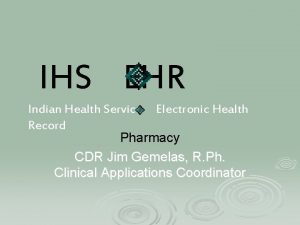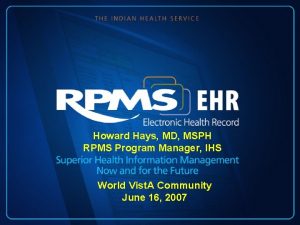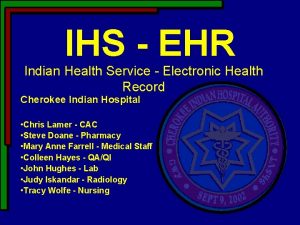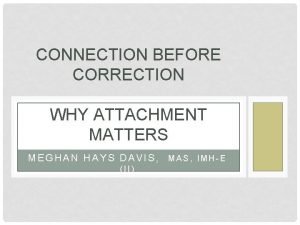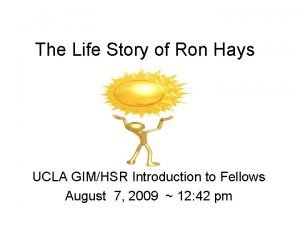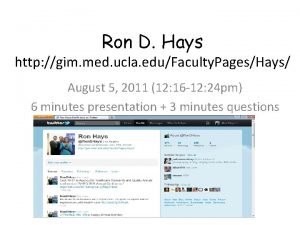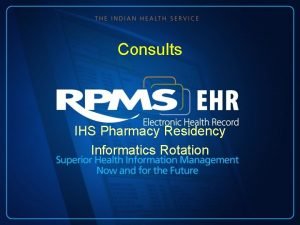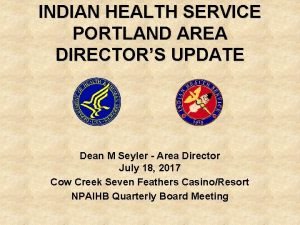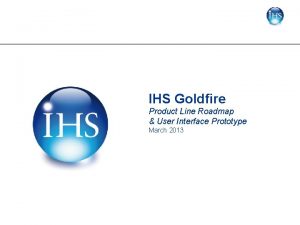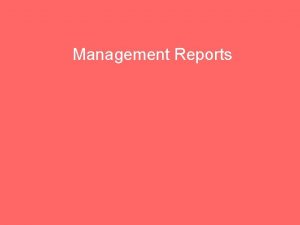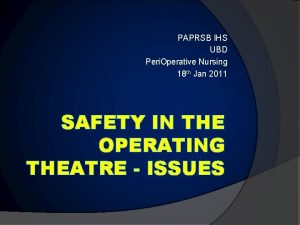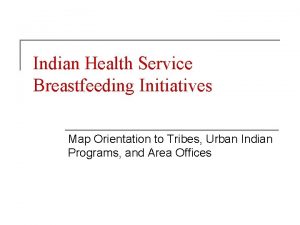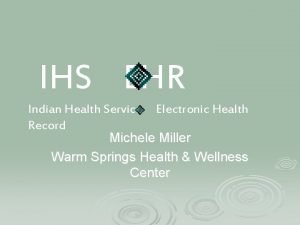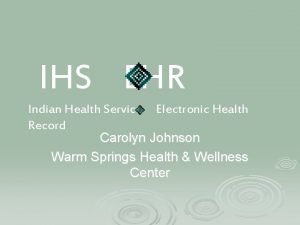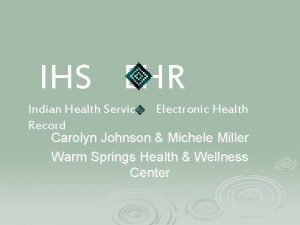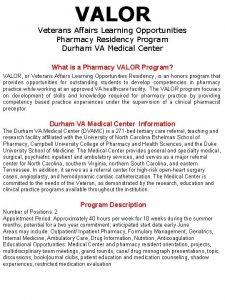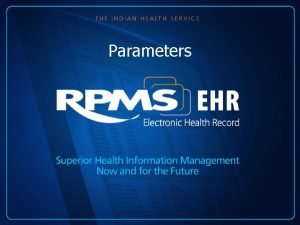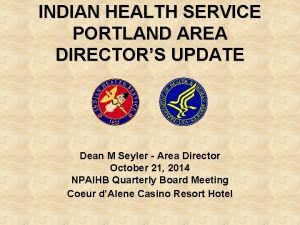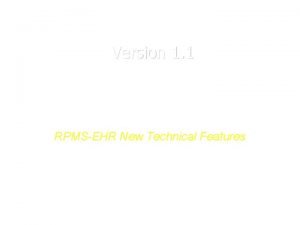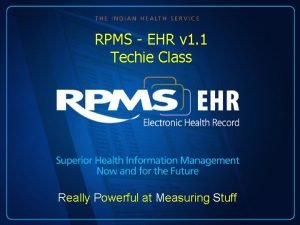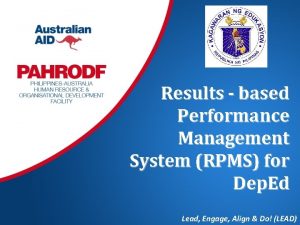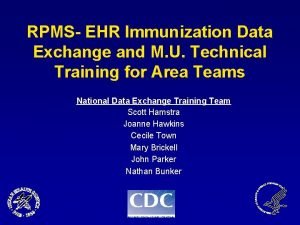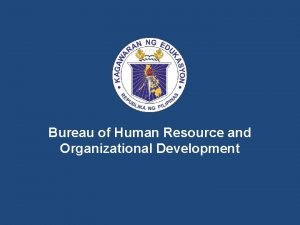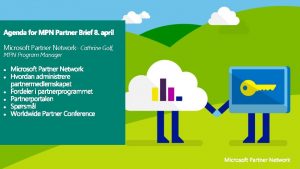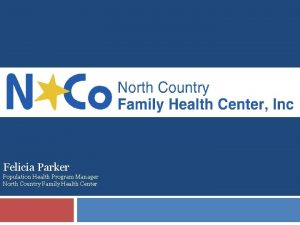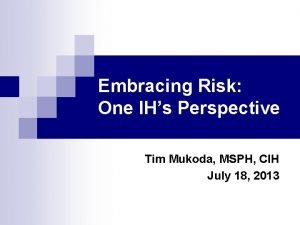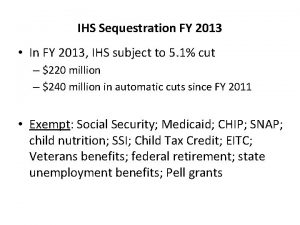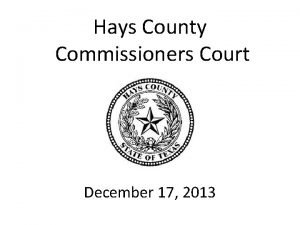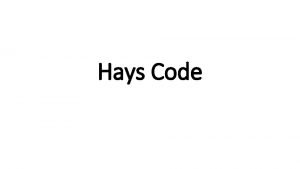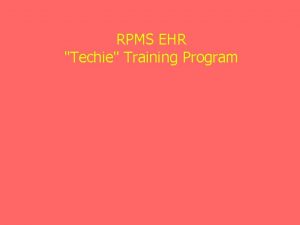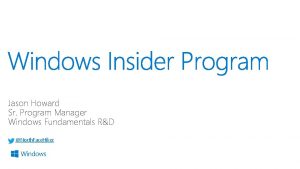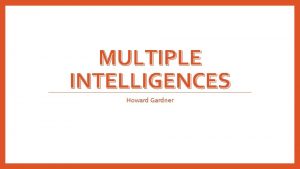Howard Hays MD MSPH RPMS Program Manager IHS



















































- Slides: 51

Howard Hays, MD, MSPH RPMS Program Manager, IHS World Vist. A Community June 16, 2007

Indian Health Service • Provides comprehensive care to over 1. 6 million American Indians / Alaska Natives • Nearly 600 health care facilities Hospitals Health Centers Health Stations Residential treatment centers Alaska village clinics Urban programs Federal 36 61 49 5 Tribal 13 158 76 28 170 34

Indian Health Service • Over 50% of programs are operated by tribes through tribally run compacted or contracted facilities • 34 urban programs are contracted to provide care to AI/AN populations in metropolitan areas • Remaining care is provided through federally operated ‘direct’ programs (majority of the user population still receives care in direct programs)

• Clinical care Data Needs – Provision of care (diagnoses, meds, results, etc. ) – Assessment of quality of care • Public Health Surveillance – Fluoridation, Immunization, Suicide, DV/IPV, etc. • Billing / Collections – Diagnosis and service codes • Research – Collaborations with CDC, AHRQ, academia • Performance Assessment – GPRA and other national measures • Legislative – Congressional reports, budget justification, etc.

Data Issues in IHS • Funding and reporting are centralized, but administration and governance are decentralized • Over half of Indian health programs are administered autonomously by tribes • Submission of health data from tribes is voluntary • Therefore, we (IHS) must provide tools for quality care and data collection that are attractive and meet the needs of all constituents, Tribal and Federal.

RPMS • Resource and Patient Management System • IHS Health Information Solution since 1984 ---- A. K. A. ---Really Powerful at Measuring Stuff

What is RPMS? • RPMS is an integrated Public Health information system – Composed of over 60 component applications – Patient and Population based clinical applications – Patient and Population based administrative applications – Financially-oriented administrative applications www. ihs. gov/CIO/RPMS

Vist. A and RPMS • Common programming/database architecture (M/Cache) • Applications shared by VHA and IHS • Many developed for use in VHA and adapted for IHS • Others developed for use in IHS, some adopted by VHA • RPMS focused around Visit data contained in Patient Care Component (PCC) • IHS uses HRN instead of SSN

IHS is not VHA • Cradle to grave care – Pediatrics – Prenatal and obstetrical care • • • Smaller facilities, more rurally located Decentralized administration Tribal autonomy Community and population-based mission Very modest IT staffing & budget

RPMS Integrates Multiple Clinical Systems

The EHR Challenge for IHS • Produce or acquire an Electronic Health Record system that: – Meets clinical and business needs of both Tribally and Federally operated facilities – Is scalable to the needs of facilities ranging from small rural clinics to medium-sized hospitals – Is affordable to facilities with no resource cushion or ability to borrow – Is sustainable into the future

RPMS – Elements of an EHR for over 20 Years Existing elements – – – Registration Scheduling Pharmacy Radiology Laboratory Immunizations Reminders (passive) Problem List Health Summary Other PCC functions Billing More. . . Lacking elements – – – Provider order entry Note authoring Point of care data entry GUI usability Active reminders & notifications

RPMS Electronic Health Record • Graphical User Interface to RPMS – User-friendly and intuitive access to RPMS database for clinicians and other staff – Componentized to allow incorporation of CPRS functionality as well as new capabilities developed within IHS – Proprietary “framework” for presentation of various GUI components

The EHR Componentized Framework

The EHR Componentized Framework

The EHR Componentized Framework

• Vue. Centric Design Mode – Build visual templates from available components, arranging them on tabs or panes in an orientation consistent with the user’s workflow

• Vue. Centric Layout Manager – Allows customization of visual user template – Orientation via tabs, tree views, splitter panes, etc. – Click and drag to modify layout – Addition of color & style enhancements – Layout according to user’s business flow



RPMS EHR Commonalities with CPRS • Notifications • Text Integration Utility – note author • Reminders application – IHS-specific national reminders • Consults application – RPMS has separate referred care application • Order Entry, Lab, Radiology, Pharmacy – Numerous IHS customizations esp with medication management

IHS-Specific EHR Components • • Medication management interface Immunizations Patient Education Problem List Diagnosis entry and coding Superbills and CPT coding Numerous others

Other RPMS Capabilities • • • Powerful Database Query Tools State Immunization Data Exchange Reference Lab Interface Support for pediatric care Support for women’s health & prenatal Behavioral Health applications Multiple Case Management applications i. Care Population Management GUI Clinical Reporting System – performance measure application (specific to IHS)

Immunization Data Exchange • IHS and Tribes share many patients with private sector – Shot records are often incomplete due to patient mobility – Risk for under- and over-immunization • Data exchange system for pediatric immunizations developed – HL-7 data files exported to and imported from State immunization registries

Reference Lab Interface • Released for Laboratory v 5. 2 (IHS patch 1021) • Uni- or Bi-directional interface with contracted reference laboratories – Unidirectional receives lab results into PCC – Bidirectional sends orders to reference lab and receives results into lab package (EHR) • Implementation is fairly labor-intensive

Well Child Care • CDC Growth Charts – in PCC+ and EHR GUI • Infant birthweight & feeding choices • Ages & Stages Questionnaire (ASQ) – Age-specific screening in 5 dimensions – Print form, record score in EHR or PCC – Guidance for abnormal screens • Well Child Knowledgebase – Thousands of age-specific reminders, education, developmental & medical screening, etc. – Nationally deployed set with local management • Additional screening tools (DDST milestones)

Prenatal Care (in development) • Data collection and entry for: – First Prenatal Visit – Interim Prenatal Visits – Postpartum Visit • • • Over 600 data points Flowchart presentation where appropriate Data carries over to future pregnancies Multiple GUI components planned Flowchart infrastructure extensible to other types of data

RPMS Behavioral Health System • First complete electronic record in IHS (1990 s) • Graphical (GUI) version released 2003 • Widely deployed throughout I/T/U system – >250 sites • Designed for A/SA, MH, and SW providers • Integrated with RPMS medical information • Supports 3 rd party billing for BH services

RPMS Behavioral Health System • Ability to document: – 1: 1 patient encounters – Group encounters – Patient Education, Health Factors and screening (depression, Et. OH, DV) – Treatment Plans and Treatment Plan reviews – Case Management Information – Incidents of Suicide/Suicidal Behavior

BH GUI Screenshot

IBH Screenshot

SRF Screenshot

RPMS Case Management Applications • Registry-based systems with reminders, performance indicators, and populationbased reporting • Immunizations • Diabetes Management System • Asthma Management System • Women’s Health • HIV Management System • Population Management (i. Care)

i. Care Population Management GUI • Graphical interface for a fully integrated case management system • Decision support and patient management for multiple chronic conditions • Nationally defined preventive and diseasespecific healthcare reminders • Customizable patient panels • Quick performance views using CRS/GPRA logic for any patient or group of patients • Plan to incorporate current and future diseasespecific register systems (DM, Asthma, HIV/STD, CVD, WH, etc. )

i. Care provides the ability to create multiple, predefined and easy-to-define patient panels. Panels are customizable and unique to the individual user.

A Panel’s Patient List

Modifying Panels Modifications made to individual panels affect that panel only Users choose which columns they’d like displayed and in what order. Each panel can have a different design

“Tags” i. Care utilizes logic written for other clinical applications to “tag” individuals with predefined diagnoses and conditions

“Flags” i. Care displays patient “flags” related to • Abnormal labs • Hospitalizations • ER visits • Unanticipated ER returns

Individual “GPRA” View User’s select which GPRA measures they’d like to view and then check to see if the measure is met for any individual patient on the panel.

Aggregated “GPRA” Statistics i. Care uses “official” GPRA report logic on user-defined populations that are not currently available in the Clinical Reporting System (CRS)

Patient Record i. Care pulls all available patient data and displays it in one view

i. Care will generate nationally-defined general prevention and disease/condition specific healthcare reminders that are integrated to display most stringent criteria applicable to the patient’s chronic condition(s)

CRS (Clinical Reporting System) • Automated reporting system for tracking over 300 clinical quality measures, including 22 GPRA measures • Intended to eliminate the need for manual chart audits • Available in both GUI and roll-and-scroll versions • Awarded 2005 Nicholas E. Davies Award of Excellence in Public Health

CRS • Identical logic ensures comparable performance data across all facilities • Updated annually to reflect changes in the logic descriptions and to add new measures • Local facilities have the option of transmitting their data for most CRS reports to their Area Office for Area Aggregate Reports

CRS 2007 Clinical Measures • 22 GPRA treatment and prevention measures • 23 other key clinical performance measure topics. Examples: – Diabetes Comprehensive Care – Osteoporosis Screening – Comprehensive CVD-Related Assessment • 22 HEDIS measure topics • 26 Elder Care measure topics (patients 55+) • 17 CMS (hospital) measures

Sample Performance Summary

Quality Measurement in IHS • Sequist, et al. “Information Technology as a Tool to Improve the Quality of American Indian Health Care”, AJPH 95: 12, Dec 2005 • http: //www. ihs. gov/cio/crs_performance_imp rovement_toolbox. asp • http: //www. ihs. gov/Non. Medical. Programs/Planni ng. Evaluation/pe-gpra. asp • http: //www. ihs. gov/Non. Medical. Programs/Budget Formulation/bf_cong_justifications. asp (see 2008 pp 202 ff)

Advantages of RPMS • Software is GOTS – public domain - mostly • Flexible implementation (minimal to full) • Accommodates paper or electronic documentation • Robust database with many standard reports and powerful queries • Supports population health mission • Occupational Health module pending • Can use local or remote database

Disadvantages of RPMS • Does not come with any support • Setup and maintenance of multiple packages can be challenging • Not web based or enabled • EHR GUI requires separate contract/license • EHR GUI requires setup of ancillary packages (pharmacy, lab, radiology) that may not be used

Discussion
 Tribal health emr
Tribal health emr Ihs rpms
Ihs rpms Service electronic
Service electronic Ihs scholarship program
Ihs scholarship program Ihs.gov scholarship
Ihs.gov scholarship Alexander hays
Alexander hays Naviance eanes
Naviance eanes Walter hays aa
Walter hays aa Jude prather
Jude prather Liz hays
Liz hays Ron hays ucla
Ron hays ucla Smartfind hays
Smartfind hays Lower trinity groundwater conservation district
Lower trinity groundwater conservation district Hays experts
Hays experts Fulbright hays summer seminar
Fulbright hays summer seminar Ron hays ucla
Ron hays ucla Curtis hays whitson
Curtis hays whitson Senior manager vs general manager
Senior manager vs general manager Portfolio manager synergy manager parental developer
Portfolio manager synergy manager parental developer Ihs ewb
Ihs ewb Service electronic
Service electronic Ihs pharmacy residency
Ihs pharmacy residency Ihs engineering workbench
Ihs engineering workbench Lame deer ihs
Lame deer ihs Ihs portland
Ihs portland Ihs
Ihs Simbolos satanicos
Simbolos satanicos Ihs honda system
Ihs honda system Ihs significado satánico
Ihs significado satánico Ihs pharmacy menu
Ihs pharmacy menu Fort defiance ihs
Fort defiance ihs Ihs dentist salary
Ihs dentist salary Ihs ubd
Ihs ubd Ihs areas map
Ihs areas map Indian health services warm springs
Indian health services warm springs Ihs ehr
Ihs ehr Ihs ehr
Ihs ehr Valor program pharmacy
Valor program pharmacy Ihs dentist salary
Ihs dentist salary Rpms ehr
Rpms ehr Portland ihs
Portland ihs New rpms guidelines
New rpms guidelines Syspdg
Syspdg Rpms ehr
Rpms ehr 4 phases of rpms
4 phases of rpms Duties and responsibilities of master teacher rpms
Duties and responsibilities of master teacher rpms Rpms ehr
Rpms ehr Deped human resource development plan
Deped human resource development plan Gsa fleet management
Gsa fleet management Microsoft partner pinpoint
Microsoft partner pinpoint Microsoft partner program manager
Microsoft partner program manager Population health program manager
Population health program manager
